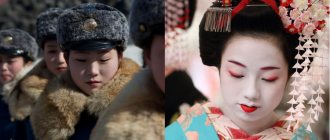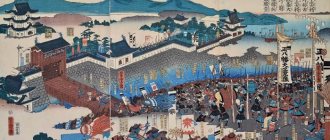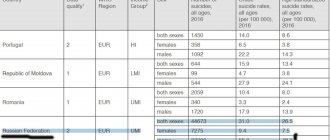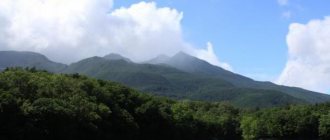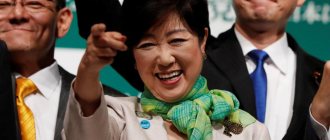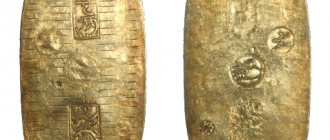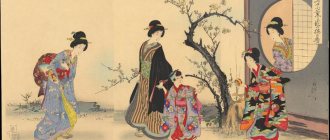Post-war reforms in Japan
According to the Potsdam Declaration, an occupation regime was established in Japan, which was supposed to carry out the demilitarization and democratization of the country.
Occupation troops, mostly American, began landing on the Japanese islands in September 1945. In its policy towards Japan, the United States sought, on the one hand, to prevent the revival of Japanese militarism as its main rival in the Far East and the Pacific Ocean; on the other hand, frightened by the revolutionary events in Asia (Vietnam, Korea, China), they were ready to go to an alliance with his yesterday's rival.
The situation of that period - the victory over fascism, the growth of the forces of democracy, socialism - created favorable conditions for the implementation of the decisions of Potsdam, and the United States was forced to take this into account. In the fall of 1945, the disarmament and demobilization of the Japanese armed forces, the destruction of military potential, and the trial of war criminals began.
Political prisoners were released from prisons, new parties and organizations were created, and democratic freedoms trampled by fascism were revived. The Communist Party of Japan (CPJ) emerged from underground, the Socialist Party (SPJ), the Congress of Trade Unions, as well as a number of bourgeois parties—liberal, democratic, etc.—were formed.
In 1946, the Japanese Constitution was adopted, legally enshrining a number of important democratic achievements of the Japanese people. According to Article 9 of the Constitution, Japan renounced the creation of armed forces and wars as a means of resolving international disputes.
Since 1947, an agrarian reform began to be carried out in Japan, bourgeois-democratic in nature (landowners' land was purchased by the state and sold to peasants, of whom, however, not all could buy it). Landownership was abolished. And although the Japanese peasant became an object of exploitation by a new predator - monopolies, the reform contributed to the growth of productive forces in the countryside and the expansion of the domestic market.
In general, during the first stage of the occupation regime (1945-1948), the process of demilitarization, democratization and denazification took place in Japan, although not always consistently and completely. Since 1948, the situation began to change. Back in 1947, an American economic mission arrived in Japan. As a result of negotiations, Japanese imperialist circles received American loans on very favorable terms.
The United States also began to implement a plan to turn Japan into its political and military partner, preparing a Japanese-American military alliance from 1948 to 1951.
The rise of an empire
The date of the emergence of the Japanese Empire, in political terms, can be considered
November 9 1867
.
On that day, Emperor Meiji
(real name Mutsuhito) received state power.
Before this, Japan had been ruled by shoguns for more than two centuries.
Before the complete victory over the adherents of the shogunate, fighting continued for several months, but officially the emperor was now the head of state.
Immediately Khan's administration
was eliminated and replaced with prefectures. Japan had the prospect of turning from a backward country with a feudal monarchy into a developed power of the European type. The previously very complex system of estates was abolished, and now all residents of the country, with the exception of the imperial family, were divided according to a system consisting of only three estates. Moreover, they all formally had the same rights. Members of the lower class were now allowed to have a surname. Shintoism was declared the only and compulsory religion of the Japanese state.
To industrialize the country, the Japanese needed to create a structure of shipbuilding facilities for the production of cotton, cement, glass, etc. The problem was solved thanks to large-scale government investments. Over time, the state retained only strategic industries, and the assets of the rest were sold at low redemption rates to such trading groups as Mitsui, Yasuda, Sumitomo and Mitsubishi
All this allowed Japan to have an established production of machine tools and electrical equipment by the beginning of
1890
. This newly formed Asian power was able to quickly launch the production of its locomotives and become an exporter of coal and copper. The growth of the textile industry was also noticeable.
At first 70
years, the Japanese government began to show interest in neighboring territories.
In the summer 1879
Ryukyu
Island was annexed .
The annexation of the Liaodong Peninsula, begun in the spring 1895
, under pressure from Russia, Germany and France, the Japanese were forced to stop.
Having received a certain indemnity, they returned this territory to China. After the Russo-Japanese War,
in
1905
Japan received the southern part of
Sakhalin Island,
retained ownership of the Korean peninsula, but was forced to renounce its claims to the Philippines.
In World War I
, Japan sided with the Entente, declaring
August 23 1914
. Without receiving serious resistance, Japanese troops quickly captured German colonies on the mainland and on the Pacific islands.
Japan's foreign policy 20-
In the 1980s, she changed seriously and became softer.
In particular, attitudes towards Korea and Taiwan have become more liberal. Shortly before the outbreak of World War II, in which it now sided with Germany, Japan's militarism reappeared. In July 1937
, Japan began military operations in China.
Revival of Japanese militarism
During the period 1952-1955, Japan concluded a number of beneficial treaties and agreements with the United States. By the mid-50s, the position of Japan's ruling classes strengthened. They developed a desire for a more independent course, without the military “tutelage” of the United States. The question of revising the 1951 security treaty was raised. The people openly expressed dissatisfaction with the government's policies. Since 1955, the so-called spring offensive of the working class began in Japan - a specific form of strikes.
During such strikes, workers increasingly began to oppose the military treaty. Anger and indignation were caused by the behavior of American military personnel, the conduct of military maneuvers, and the construction of military facilities. By 1956, there were up to 675 American military bases in Japan, covering an area of 137 thousand hectares.
In 1958, under pressure from the Japanese progressive public and the general public, the government began negotiations to revise the security treaty. Negotiations ended in 1960 with the signing of a new agreement “on mutual cooperation and security guarantees.”
This was actually an extension of the previous treaty for the next 10 years, only now Japan was not a passive partner, but had certain military obligations for joint actions with the United States. The United States still retained the right to establish military bases on Japanese territory. By keeping more than 40 thousand American troops in Japan and having missile launchers, the United States sought to use Japan as a base for aggression.
The 1960 treaty caused a new wave of protest and indignation among the Japanese people. Under the leadership of the largest professional, a general political strike was held. As a result, the government that signed the 1960 treaty was forced to resign. But the situation remained the same, the ruling circles of Japan remained tightly connected with American imperialism.
Ten years later, despite continued protests from Japan's progressive political circles and popular protests, the treaty was again extended indefinitely; Japan achieved the return of the Okinawa islands to it, albeit with the preservation of US military bases on them.
Constitution of Japan
Definition 1
The Constitution of Japan is the fundamental law of Japan, which came into force on May 3, 1947.
Note 1
The Constitution is formally a series of amendments to the Meiji Constitution, but is traditionally considered a separate Constitution.
Finished works on a similar topic
Coursework Japan after the Second World War 480 ₽ Essay Japan after the Second World War 280 ₽ Test paper Japan after the Second World War 220 ₽
Receive completed work or specialist advice on your educational project Find out the cost
After its adoption, no amendments were made to the Japanese Constitution.
It is believed that it was the refusal to restore military power that became one of the main factors in Japan's economic growth after World War II.
When developing the Constitution, the historical experience of the formation of authoritarian regimes was taken into account, including the Hitler regime in Germany, which overcame the restrictions of the Versailles Treaty on limiting the armed forces of Germany. To create a constitutional guarantee against the revival of an authoritarian regime in Japan, the Constitution reduced the imperial role to a nominal one. His ability to influence domestic and foreign policy was significantly limited. The imperial figure became a symbol of the nation, and the fullness of state power was completely concentrated in the hands of the cabinet of ministers responsible to parliament.
Also, a restriction in the sphere of state security was the establishment of a ban for the military to hold ministerial posts.
Japan in the second half of the 60s and in the 70s
By the mid-60s, the Japanese economy had reached a high level of development, taking first place in the capitalist world in terms of production rates. In the 70s, it overtook many other industrial countries in the most important sectors of the economy: shipbuilding, chemical industry, steel smelting, electronics, artificial silk production, etc.
Foreign trade has become of great importance for Japan, which is poor in mineral resources. Foreign economic relations, which had been poorly developed during the occupation regime, grew rapidly. Japanese goods filled the markets of Asia, Africa, Latin America, and Europe; The main place in foreign trade turnover remained with the United States.
The economy of modern Japan is dominated by monopoly capital. There are 6 large financial and political groups: Mitsubishi, Mitsui, Sumitomo, Fuji (Yasuda), etc. Giant trusts are being formed that control entire industries. The public sector occupies a large place in the Japanese economy.
Occupation of Japan by Allied Forces
Have questions about this topic? Ask a question to the teacher and get an answer in 15 minutes! Ask a Question
After Japan's surrender in World War II, it was occupied by the troops of its former enemies. During this time, Japan had no sovereignty; the emperor and government were subordinate to the Supreme Commander of the Allied Forces. The most important task of the occupation forces was the demilitarization of Japan. Within a year, the Tokyo Process was implemented, the country's Constitution was adopted, and the gradual restoration of the Japanese economy began. The occupation ended with the entry into force of the San Francisco Peace Treaty.
Japanese economic miracle
The Japanese Economic Miracle is the economic and historical phenomenon of the record-breaking growth of the Japanese economy that began in the mid-1950s and continued until the oil crisis of 1973. Economic growth was almost 10% annually, the highest growth rate of any developed country at the time. The reasons for the “miracle” include low taxes and the rapid absorption by Japanese science of technologies that almost did not enter the country before the Second World War due to the isolating foreign policy of the authorities.
The rapid growth of the economy allowed Japan in the shortest possible time not only to recover completely after a military defeat, but also to take second place in terms of economic power, consistently beating France, Italy, Canada, Great Britain, Germany, the USSR and, in the end, second only to the United States. Japan was listed as the second economy in the world for more than 40 years: from 1968 to 2010, when it lost to China.
Distinctive features of the Japanese economy in the era of the “economic miracle”:
- the association of resource suppliers, manufacturers, product distributors and banks into keiretsu - closely related groups;
- mutually beneficial relations between government and entrepreneurs;
- guarantees of lifetime employment in large manufacturing corporations;
- activity of the trade union movement.

